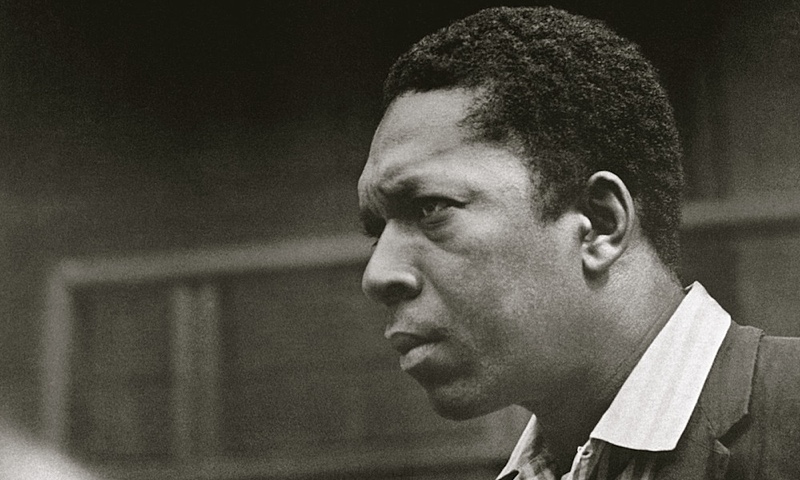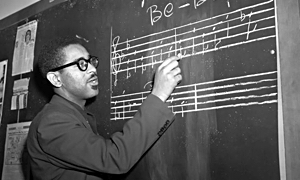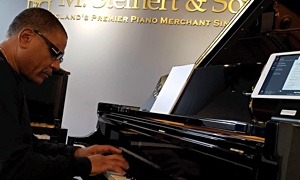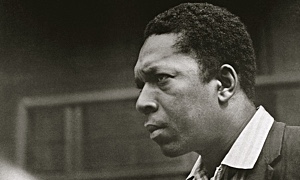Home » Jazz Articles » Jazz Primer » John Coltrane and the Meaning of Life
John Coltrane and the Meaning of Life

The man is simply compelling. Few are tepid or undecided about Coltrane's sound. I have heard many say, "I don't understand it," if they are being polite in the presence of a fan. I once played "Transition," a piece from Coltrane's classic quartet, for a group of philosophy students in my home. I demanded silence and got it. (I was their professor, after all.) When the piece was over, one bright young woman said, "I wasn't sure if they knew how to play their instruments." I assured her that they did. You acquire a taste for this music—what T.S. Eliot called "educated taste"—or you remain far from it. This is either because of you have no interest in it or because of a positive distaste for it. Some critics know Coltrane and jazz well and despise what they hear. In Cultural Amnesia, the British critic, Clive James, wrote of "the full, face-freezing, ¬gut-churning hideosity of all the things Coltrane" when comparing his style to the more restrained and concise Ben Webster. But James is an exception. Most of those who have paid careful attention to Coltrane's music find themselves entranced. They become intrigued by this quiet man's quest for musical perfection and for the depths of reality itself.
These matters pertain to the meaning of life. Some seem to shun such concerns. They avoid the question and instead care for little beyond the present moment, its duties and diversions. Others shout "No!" "The moment a man questions the meaning and value of life, he is sick, since objectively neither has any existence," wrote Sigmund Freud. Freud's disciple—and later prodigal—Carl Jung, questioned Freud's denial. He instead, offered this: "The decisive question for man is: Is he related to something infinite or not? That is the question of life." There is no purpose in seeking what matters most if nothing matters at all.
Holocaust survivor and psychiatrist, Viktor Frankl wrote in Man's Search for Meaning, "What man actually needs is not a tensionless state but rather the striving and struggling for some goal worthy of him. What he needs is not the discharge of tension at any cost, but the call of a potential meaning waiting to be fulfilled by him."
Coltrane felt that tension between the striving and the ideal, however dimly perceived. He discerned that there is more than what appears, what can be measured or, what can be manipulated by technologies. With this music as his vehicle, he earnest journeyed toward an unknown, but alluring, end. Jazz critic, Hentoff, who knew Coltrane personally, said this,
"This was a man who was always searching, and therefore always evolving. That is why in his live performances, some of which have been recorded, he could go on for an hour and a half on one song, because he was always looking deep, trying to discover what else could be said."
That one quality that can always be expected from Coltrane is intensity. He asks so much of himself that he can thereby bring a great deal to the listener who is also willing to try relatively unexplored territory with him.
Jazz virtuosos are usually known only for their playing, composing, and arranging of music, and not for their philosophical or spiritual predilections. One can imbibe all things Miles Davis, but find little to nothing on his worldview. (There is much to read about his sordid personal affairs.) Miles was about music, not metaphysics or mysticism. This is not to deny that many jazz musicians have spiritual aspirations; but few of them overtly integrate these ambitions into the fabric of their music. This was not so for John Coltrane. In the liner notes for the 1997 edition of Giant Steps, Hentoff distilled Coltrane's passion: "All musicians worth hearing during, and beyond, their time, keep growing as their music deepens its hold on the listener. But John Coltrane committed his very existence to continually searching for more possibilities in his music—and therefore, in himself. After all, he once told me, 'The music is the whole question of life itself.'"
"Pursuance," the title of the second movement his signature recording, A Love Supreme (1965), gathers the elements of Coltrane's life and constitutes his humble charisma. His career did not begin with fireworks. Those would come later. Unlike his friend, Sonny Rollins, Coltrane did not ravish the jazz world at a young age. He played with several groups, the most prestigious of which was Dizzy Gillespie's big band. He was not a stand out, but simply a man in the horn section. The biggest break came when Miles Davis hired him for his quintet. Throughout his career as a leader, Miles had an uncanny ear for potential. He offered his chosen musicians an open sky in which to fly.
Coltrane's intense and tense solos were a sharp counterpoint to Miles's mellifluous and minimalist offerings. In the documentary, "The World According to John Coltrane," drummer Jimmy Cobb reported that Miles was sometimes nonplussed by the length of Coltrane's solos and confronted him about this. Coltrane responded that he had so many ideas that he did not know how to stop. Miles replied, "Take the horn out of your mouth." But Coltrane's passionate pursuit of perfection allowed for no such editing. He told Miles that he had trouble "getting it all in," and in the right order.
To this point, Coltrane invested all in his craft and was finding some success. He not only played and practiced music; he analyzed its formal nature by mastering musical theory. He pursued a sound, his sound—but the journey was uneven and often unheralded. Hentoff, at least initially, did not care for his approach to the saxophone. (He would later laud Coltrane lavishly and repeatedly. He is still doing so.) He writes: Having grown up on Lester Young, Coleman Hawkins, Buddy Tateand Don Byas, it took me some time to be drawn into John Coltrane's universe. In Down Beat, at first, I wrote of his unappealing sound on records, and in clubs I tended to lose my way in his long dense solos. However, Hentoff and most other critics found their way to understanding the musical language of the "fiery tenor." When asked if he was angry when he performed, Coltrane said that the only person he might be angry with was himself, since he was not playing at the level he was pursuing.
Just as Coltrane was finding his voice, language, and sensibility as a jazz musician, his life was hampered by heroin addiction—as was true for so many jazzmen at that time. Since the habit was making him unreliable, Miles Davis fired him after a life performance in 1957. Shortly after this, Coltrane, without medical help, went cold turkey, leaving his drug addiction behind. In the notes to "A Love Supreme," Coltrane wrote, "In the year of 1957, I experienced, by the grace of God, a spiritual awakening, which was to lead me to a richer, fuller, more productive life." However, his positive addiction to music persisted until the end of his all-too-short life. After this, Coltrane played for six months with pianist Thelonious Monk at The Five Spot in New York City. Like Miles, Monk gave Coltrane the space to develop his unorthodox, but tradition-grounded, style. Coltrane related that Monk's complex music demanded a discipline that shaped him profoundly. Monk's solos worked within the melody of a tune. This differed from Coltrane's more harmonic approach. After his brief, but consequential, tenure with Monk, Coltrane complimented his mentor as "a musical architect of the highest order." This collaboration was scantily recorded, but in 2005, Blue Note released "The Thelonious Monk Quartet with John Coltrane," which documents this felicitous, if short-lived, partnership. In 2013, Oxford University press released Thelonious Monk Quartet with John Coltrane at Carnegie Hall by Gabriel Solis, which carefully explores this event in depth. Coltrane continued to drive himself toward musical growth, and he was succeeding.
During his later time with Miles and while he was releasing albums as a leader, Coltrane began playing what jazz writer Ira Gitler called, "sheets of sound." Jazz saxophonists had never played like this way. This phrase refers to the torrents of arpeggios Coltrane played during solos. In the liner notes to Coltrane's recording, "Traning In," Gitler wrote of Coltrane's "excruciatingly, exhilarating intensity of rapid exigent runs with their residual harmonic impact." When speaking to Hentoff, he said, "His continuous flow of ideas without stopping really hit me. It was almost superhuman. The amount of energy he was using could have powered a spaceship." Hentoff himself put it this way, "These 'sheets of sound' were multi-note hailstorms of dense textures that sound like a simultaneous series of waterfalls." But the "sheets of sound" style was neither a way-station nor a destination for Coltrane. As Hentoff said, "Coltrane never coasted." It was rather a rung on the ladder, the top of which Coltrane could not yet see.
Cleaned up and musically matured, Coltrane rejoined the Miles Davis group in 1957. During his second stint with Miles, he recorded some of his best work to date. This culminated in the modern classic, Kind of Blue (1959). The spacious, cooler, modal style of that album offered Coltrane a structure to develop his ideas in a more grounded and less frenetic manner than found in the hot, hot bebop and bebop-influenced music. This music never lacked force or propulsion. Its fire was found in the relative simplicity of the chord progressions and the more leisurely time given for solos. Patrick Spitzer gives a more musically-specific explanation:
"The term "modal jazz" refers to improvisational music that is organized in a scalar ("horizontal") way rather than in a chordal ("vertical") manner. By de-emphasizing the role of chords, a modal approach forces the improviser to create interest by other means: melody, rhythm, timbre, and emotion. A modal piece will generally use chords, but the chords will be more or less derived from the prevailing mode."
This radical innovation, pioneered by Miles Davis, put no little demands on the musicians who worked it out. Miles himself demanded excellence from his bandmates, but also gave them great freedom to experiment. Coltrane ventured fearlessly—but not recklessly—into the musical frontier of modal jazz. During his last tour with Miles in Europe in 1960, Coltrane was playing differently, and more adventurously, than he had on "Kind of Blue." One can hear him strain and experiment, sometimes perplexing the audiences. After soloing on "All Blues" in Zurich, Switzerland, on April 8, 1960, John Coltrane was booed. But he was undaunted, searching, exploring all that music could do in and through him. During the tour, Coltrane gave an interview on French radio during which he said that he had so many ideas in his head it was difficult to know where to put all of them. He knew he was in process, but he was not sure where he would end up. Coltrane was not a musician to settle into a set style from which he would never, or only slightly, deviate. Coltrane found even more freedom and possibilities for modal jazz in his intrepid "classic quartet" (1960-65).
He had recorded as a leader before, yet the near telepathy he experienced with The Classic Quartet was uncanny. Interactive energy, synergy, and sympathy existed among Elvin Jones on drums, Jimmy Garrison on bass, and McCoy Tyner on piano. It was unparalleled in Coltrane's career—and, in fact, in all of jazz history. Coltrane's tone and technique grew exponentially in this sonic company, as did his ability to listen and respond to other members of the band. He found much of what he was looking for during his tenure with this quartet—but not all.
This was Coltrane's first experience as the leader of a touring ensemble. It began with Reggie Workman on bass, but Jimmy Garrison soon took his place and remained with Coltrane longer than the other members—that is, until the end. Like Coltrane, drummer Elvin Jones was pushing the traditional limits of jazz in his time-keeping. Jones's energy matched that of his leader. While he never lost the beat and could swing furiously, Jones never laid down a repetitive groove. Instead, he varied the approach through his accents, dynamic range, and propulsive creativity. Jones and Coltrane enjoyed risk-taking and exploratory reciprocity, which sparked them both toward greater heights of virtuosity. The depth and richness of this dialogue remains unique in jazz.
McCoy Tyner on piano gave grounding as well as forceful solos. He, too, was keenly in sync with the rest of the band. Jimmy Garrison on bass could swing and risk with finesse and power and was one of the best soloists on his instrument. Each member had "big ears," a term in jazz meaning the knack of listening and responding to the playing of others in real time on the stage or in the recording studio.
The members of classic quartet meshed so well that they seldom rehearsed after they had established their alchemy. Coltrane might give some brief instructions before a tune, but the rest was forged through extended improvisations. There was an open sky. They were looking up, unafraid. Jones said in an interview with Terri Gross on National Public Radio's "Fresh Air," that the group's interactions were "almost telepathic."
In the book, Flow: The Psychology of Optimum Experience, psychologist Mihaly Csikszentmihalyi explains that we sometimes have experiences in which our abilities, joys, and a sense of purpose merge and produce a heightened state of awareness and he calls "flow." All things pedestrian are transcended in these magic moments or hours. "Flow states" can be experienced by athletes performing at their peak, by surgeons totally engaged in their operations, and more. Becoming one with their music is such a flow state for musicians. They experience it either individually or with other musicians—often transporting their audience with them.
This path-breaking group reached its apex with the recording of "A Love Supreme," released in early 1965. Coltrane had been seeking musical innovation and spiritual enlightenment passionately since he kicked heroine in 1957. A Love Supreme was offered to the God he who had delivered him and given him a radically new perspective on life. He writes in the liner notes:
"During the year 1957, I experienced, by the grace of God, a spiritual awakening which was to lead me to a richer, fuller, more productive life. At that time, in gratitude, I humbly asked to be given the means and privilege to make others happy through music. I feel this has been granted through His grace. ALL PRAISE TO GOD."
He did make others happy though his music as I can attest. For many, this is most evident on "A Love Supreme." Unlike Coltrane's previous recordings, this effort is one thirty-nine minute piece of music consisting of four movements: Acknowledgment, Pursuance, Resolution, and Psalm. Jazz writer Michael Cuscana notes that "this four-part suite, [is] simple in construction but rich in content." It also became one of the most popular and seminal recordings in the history of jazz. A Love Supreme is a work of modal jazz; but it transcends Coltrane's early efforts in this genre because of its focus, intensity, and group dynamics. The musical structure is that of a soul in search of The Supreme, which for Coltrane, was God. In the poem that accompanies the liner notes, he writes of a time of wondering away from God. However, he returned.
"I do perceive and have been duly re-informed of His OMNIPOTENCE, and of our need for, and dependence on Him. At this time I would like to tell you that NO MATTER WHAT ... IT IS WITH GOD. HE IS GRACIOUS AND MERCIFUL. HIS WAY IS IN LOVE, THROUGH WHICH WE ALL ARE. IT IS TRULY—A LOVE SUPREME."
The music manifested in this session is sublime and evokes a kind of attention-getting awe for those who listen carefully and repeatedly. It took several listens for one of my students to "get the music." The epiphany occurred when he was listening to A Love Supreme in his car. The experience was so consuming that he had to pull his car to the side of the road to take it in. I am no stranger to these irruptions.
Instead of evaluating this suite movement by movement, delving into one passage of Part I of "A Love Supreme" gives us a window into Coltrane's apprehension of universal meaning. Lewis Porter, a professor and an expert on John Coltrane's life and music, observes that in "Acknowledgement," Coltrane plays the "Love Supreme" four-note motif in every possible key. By playing these twelve keys Coltrane is musically affirming that "a love supreme" (God) exists in every possible dimension of existence. Lewis Porter notes:
"He's saying it's everywhere. It's in all 12 keys. Anywhere you look, you're going to find this "Love Supreme." He's showing you that in a very conscious way on his saxophone."
After recording A Love Supreme, Coltrane added other players to the group—such as the histrionic saxophonist Pharoah Sanders and his second wife, Alice, on piano—and minimized structure for the sake of rather unguided sonic searching. Jones and Tyner soon left the group, but Garrison remained for the duration. This music left many listeners behind, but Coltrane kept looking ahead even if the destination was not in sight. His last (poorly) recorded gig, The Olatunji Concert, was released by Impulse in 2001. After one more unrecorded concert, John Coltrane died of liver cancer on July 17, 1967. The jazz world was stunned and grieved. Jazz guitarist John McLaughlin said his knees shook upon hearing the news.
What can the life of this man tell us about the meaning of life? So much can be said, but let me return to a theme of this essay: Coltrane's pursuit of meaning. Coltrane was not alone. We all seeking meaning—some purpose and significance beyond ourselves, which, nevertheless, bears on our condition The Oxford don, C.S. Lewis believed that yearning and searching for transcendence revealed the deep core of human beings. We desire many things we do not achieve (success, wealth, and health). This desire for something more than mere earth can afford is universal and insistent. We find it in Coltrane's unceasing quests. Could that longing—expressed in the poetry, philosophy, and the music of the ages—all come to nothing? Might Shakespeare's MacBeth have the last word?
Life's but a walking shadow, a poor player That struts and frets his hour upon the stage And then is heard no more. It is a tale Told by an idiot, full of sound and fury, Signifying nothing.
Does the life and music of John Coltrane signify nothing? Was his pursuit pointless? I think not. Part of the meaning of life is that humans seek meaning and meaning is worth pursuing. We are meaning-seeking beings, and cannot be otherwise. Even those who dispense with all meaning—such as Bertrand Russell who called the world "a chance collocation of atoms"—still find meaning in trying to convince others that there is no meaning. Few have sought meaning and beauty and truth more soulfully than John Coltrane; yet, to our knowledge, he was never quite satisfied. Are any of us? We find meaning, we seek for more meaning. What does all this tell us about ourselves and our world? C.S. Lewis offers an arresting idea from his essay, "The Weight of Glory."
"Creatures are not born with desires unless satisfaction for those desires exists. A baby feels hunger: well, there is such a thing as food. A duckling wants to swim; well, there is such a thing as water. Men feel sexual desire: well, there is such a thing as sex. If I find in myself a desire which no experience in this world can satisfy, the most probable explanation is that I was made for another world. If none of my early pleasures satisfy it, that does not prove that the universe is a fraud. Probably earthly desires were never meant to satisfy it, but only to arouse it, to suggest the real thing."
Coltrane was in search of "the real thing," which he identified as God in A Love Supreme. Many have found the music of John Coltrane to be a kind of portal, an opening to transcendence, and a reason to return thanks. Free jazz saxophonist Peter Brötzmann, who shows no signs of religiosity, says that "music comes from somewhere else." Some music, in its sublimity, evokes humility before a reality for which humans are not entirely responsible and which they have not entirely grasped. Perhaps the Teacher of old put it best:
"He has made everything beautiful in its time. He has also set eternity in the human heart; yet no one can fathom what God has done from beginning to end (Book of Ecclesiastes, chapter three, verse eleven)."
There may be more yet to this "Love Supreme" than Coltrane grasped. Indeed, I think so. But his ardent "pursuance" should spur us on to seek the higher things while we can.
< Previous
What Is This Thing Called?
Next >
How to Listen to Jazz
Comments
Tags
John Coltrane
Jazz Primer
Douglas Groothuis
Elvin Jones
Lewis Porter
Sonny Rollins
Dizzy Gillespie
Miles Davis
Buddy Tate
Don Byas
Thelonious Monk
McCoy Tyner
Reggie Workman
Jimmy Garrison
Pharaoh Sanders
john mclaughlin
Peter Brotzmann
For the Love of Jazz
 All About Jazz has been a pillar of jazz since 1995, championing it as an art form and, more importantly, supporting the musicians who create it. Our enduring commitment has made "AAJ" one of the most culturally important websites of its kind, read by hundreds of thousands of fans, musicians and industry figures every month.
All About Jazz has been a pillar of jazz since 1995, championing it as an art form and, more importantly, supporting the musicians who create it. Our enduring commitment has made "AAJ" one of the most culturally important websites of its kind, read by hundreds of thousands of fans, musicians and industry figures every month.























